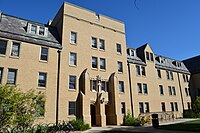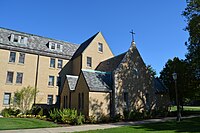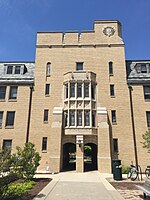Howard Hall (University of Notre Dame)
| Howard Hall | |
|---|---|
 | |
 | |
| Campus quad | South |
| Established | 1924 |
| Named for | Timothy Edward Howard |
| Colors | Yellow and green |
| Gender | Female |
| Rector | Anna Kenny |
| Undergraduates | 145 |
| Chapel | Our Lady of Lourdes |
| Mascot | Ducks |
| Interhall sports | Basketball, bowling, cross country, dodgeball, flag football, golf, lacrosse, racquetball, soccer, table tennis, tennis, volleyball |
| Charities | National Bone Marrow Donor Program |
| Major events | Annual Bone Marrow Drive, Totter for Water, Chapel Crawl |
| Website | http://www.nd.edu/~howard |
Howard Hall | |
| Location | Notre Dame, Indiana |
| Coordinates | 41°42′03″N 86°14′30″W / 41.7007°N 86.2418°W |
| Built | 1924 [1] |
| Architect | Francis Kervick & Vincent Fagan |
| Architectural style | Collegiate Gothic |
| Part of | University of Notre Dame: Main and North Quadrangles (ID78000053) |
| Added to NRHP | May 23, 1978 |
Howard Hall is one of the 32 Residence Halls on the campus of the University of Notre Dame and one of the 14 female dorms. It is located north of South Dining Hall on University of Notre Dame's South Quad, and is immediately surrounded by Badin Hall on the east, Morrissey Manor on the west, and Bond Hall on the north.[2] Built in 1924-1925, it is dedicated to Timothy Edward Howard, and hosts 145 undergraduates. The coat of arms is based on that of the Howard family adapted to fit Howard Hall, changed to match those of the hall, and the lions were substituted with ducks (the hall mascot).
History
Construction on Howard Hall began in September 1924 and was completed in the summer of 1925 as the first of three new freshman dorms built by president Walsh; Morrissey and Lyons Halls followed in the next few years.[3][4] The construction of these dorms was a response to the high number of Notre Dame's collegiate students living off campus and the rapid increase in student population after World War I. The building of these dorms was assigned to the architecture firm of Francis W. Kervick (1883-1962) and Vincent F. Fagan (1898-1951), who were also professors at the Notre Dame department of architecture, and construction was contracted to Sollitt Construction.[5]

Howard Hall was the first instance of a Notre Dame building being built in the collegiate Gothic style, and together with Morrissey and Lyons they formed a semi-closed gothic courtyard that inspired subsequent gothic architecture on campus.[6] The buildings still employed the classic yellow brick and minimal limestone, in order to blend with the pre-existing campus.[7] Because of their location, new style, and beauty, the three dorms acquired the name of "Gold Coast".[8][9] Howard Hall was also the first building to be named after a lay person – Notre Dame Law Professor, poet, Civil War soldier, historian, first Laetare Medal winner and Indiana State senator and Indiana Supreme Court Justice Timothy Edward Howard.[10][11] It was the first building of the Freshman Unit to be built, and was later followed by Morrissey Hall and Lyons Hall, and when it opened in the fall of 1925 it hosted about 150 freshmen.[12]
The dorm was converted from a male to a female residence hall in 1987, during the period in which the University shifted to co-education and planned to increase the female population by 150 annually from 1987 to 1990, requiring the conversion of male halls into female ones and the construction of new ones.[13] The decision and the short notice communication was heavily protested by Howard residents, who wore black or white armbands and hung protest signs, labeling themselves as the "Howard Homeless" and formed the "Howard Liberation Organization" to lament the loss of a fraternity-like atmosphere and such Howard traditions as the Howard Hat and Tie Party.[14] The decision was also protested by Howard residents in the Student Senate, where the Senate agreed to support Howard in the writing of a letter to the administration denouncing the lack of communication with the hall rector and staff and the short notice given to residents.[15] The new rector as Howard opened in 1988 was Sister Mary Jane Griffin, previously rector of Farley.[16] The Howard mascot was Word, until 1991 when they voted to change it to the Ducks.
Architecture
It is a brick building rising four floors and built in an austere collegiate Gothic style, with low eaves ridges and gables of different sizes.[17] The building is centered around a tower that surmounts an archway, from where two oak doors lead to the North and South wing respectively. The archway is surmounted by a large carved bay window that runs thought two floors and climates in an adorned parapet.[18] Among the bas-relief of the arch are depiction of classic campus images: football, a squirrel, own (symbol of wisdom), and a student pouring over books.[19] The double archway that separates the first floor into two sections and passes under the upper three floors of the hall. Adorning these arches and the other main entrances to Howard are a number of gargoyle-type stone carvings depicting anything from an owl to a student who has just received a less-than-stellar report card. To the west, the archway is adorned with a statue of Saint Timothy by James Kress; Timothy being the first name of Howard, namesake of the hall.[20][21] The chapel, dedicated to Our Lady of Lourdes, features a pietà by sculptor Jean de Marco.
Traditions
The Duck mascot was chosen after the 1986 film Howard the Duck by George Lucas.[22] Although it is one of the smallest dorms on campus, Howard Hall has a number of signature events throughout the year. Among these events are the Howard Hoedown (a fall dance), Totter for Water (a 24-hour teeter-totter fundraiser designed to help third world countries access clean water), Howard Halliday (a miniature Christmas tree decorating event to raise money for local charities), and Walk for More Tomorrows (a spring event to raise awareness for suicide prevention).[23][24][25]
In 2010, Howard Hall was named Women's Hall of the Year by Hall President's Council. In 2012, Howard Hall was awarded the distinction of being Hall of the Year.[26]
Notable residents
Gallery
-
East side of Howard Hall, with its arch
-
South Side with its chapel
-
Main Entrance
References
- ^ "Official Building Inventory" (PDF). Facilities Design and Operations. University of Notre Dame. 1 October 2015. Archived from the original (PDF) on 4 March 2016. Retrieved 11 November 2015.
- ^ "Howard Hall". Division of Student Affairs, University of Notre Dame.
- ^ Scholastic. 58 (1): 16. 1924 http://www.archives.nd.edu/Scholastic/VOL_0058/VOL_0058_ISSUE_0001.pdf. Retrieved 7 June 2020.
{{cite journal}}: Missing or empty|title=(help) - ^ Tucker, Todd (2018). Notre Dame vs. the Klan: : how the fighting Irish defeated the Ku Klux Klan. University of Notre Dame Pess. ISBN 9780268104368.
- ^ Kervick, Francis. "The Architects of Notre Dame" (PDF). The Notre Dame Alumnus. 17 (2): 40. Retrieved 4 June 2020.
- ^ "December 2002". www.irishlegends.com. Retrieved 4 June 2020.
- ^ Kervick, Francis. "The Architects of Notre Dame" (PDF). The Notre Dame Alumnus. 17 (2): 40. Retrieved 4 June 2020.
- ^ "Irish Legends: Campus Tour III". IrishIllustrated.com. Retrieved 4 June 2020.
- ^ Vonada, Damaine (August 15, 1998). Notre Dame : the official campus guide. Notre Dame, IN: University of Notre Dame Press. ISBN 0268014868.
- ^ Museum, Randy Ray The History. "A Look Back: Timothy Howard was a citizen, author and historian of St. Joseph County". South Bend Tribune. Retrieved 4 June 2020.
- ^ Tucker, Todd (2018). Notre Dame vs. the Klan: : how the fighting Irish defeated the Ku Klux Klan. University of Notre Dame Pess. ISBN 9780268104368.
- ^ "The New Year at Notre Dame" (PDF). The Notre Dame Alumnus. 4 (1). October 1925. Retrieved 4 June 2020.
- ^ Heilmann, Mary (1986-12-09). "Howard Hall to house women next fall" (PDF). The Observer. 21 (64): 1.
- ^ Heilmann, Mary (1986-12-09). "Howard Hall to house women next fall" (PDF). The Observer. 21 (64): 1.
- ^ Heilmann, Mary (1986-12-09). "Howard Hall to house women next fall" (PDF). The Observer. 21 (64): 1.
- ^ "Farley rector meets challenge" (PDF). The Observer. 21 (129): 3. 1987-04-23. Retrieved 4 June 2020.
- ^ "The New Year at Notre Dame" (PDF). The Notre Dame Alumnus. 4 (1). October 1925. Retrieved 4 June 2020.
- ^ "The New Year at Notre Dame" (PDF). The Notre Dame Alumnus. 4 (1). October 1925. Retrieved 4 June 2020.
- ^ Vonada, Damaine (August 15, 1998). Notre Dame : the official campus guide. Notre Dame, IN: University of Notre Dame Press. ISBN 0268014868.
- ^ "Campus Statue Project". Notre Dame Archives News & Notes. June 17, 2011. Retrieved November 6, 2019.
- ^ Lyman, William. "Campus Statues - Baffle & Bore" (PDF). The Notre Dame Scholastic. 89 (20): 14. Retrieved November 6, 2019.
- ^ Vonada, Damaine (August 15, 1998). Notre Dame : the official campus guide. Notre Dame, IN: University of Notre Dame Press. ISBN 0268014868.
- ^ "Howard Hall // Campus Tour". University of Notre Dame.
- ^ "Howard Hall hosts annual Totter for Water | News Break". News Break. Retrieved 4 June 2020.
- ^ "Congregation of Holy Cross". www.holycrossusa.org. Retrieved 4 June 2020.
- ^ "Archive". Hall Presidents Council, University of Notre Dame. Retrieved October 18, 2017.
- ^ "Notre Dame Directory 1952-1953" (PDF). Retrieved January 31, 2019.
External links
Sources
- University of Notre Dame residence halls
- 1924 establishments in Indiana
- National Register of Historic Places in St. Joseph County, Indiana
- Historic district contributing properties in Indiana
- University and college buildings on the National Register of Historic Places in Indiana
- University and college buildings completed in 1925





